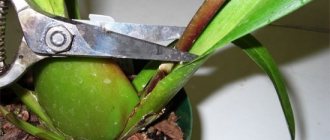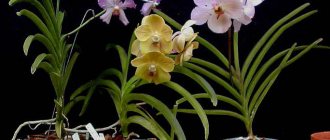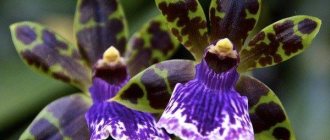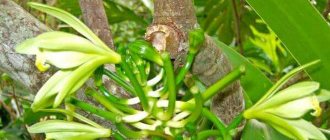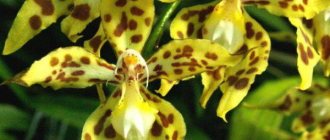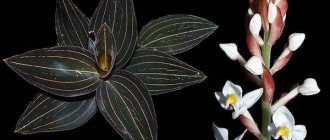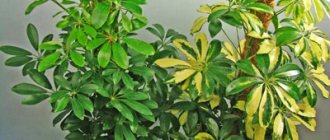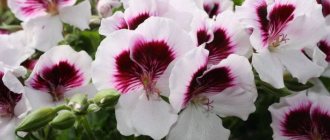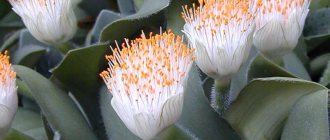Garden orchid, lovingly selected and carefully cared for, will be the pride of any gardener, delighting with spectacular and touching flowers for many years.
The key to success is
well-chosen :
- Landing place;
- Substrate;
- Lighting mode;
- Humidity and watering regime;
- Feeding;
- Wintering conditions.
Errors in at least one of these conditions can lead to failure of flowering and even death of the plant.
general description
Most of the orchid family is native to the tropics and subtropics. However, species are known that grow freely in temperate climates and even in Siberia. They, like some tropical varieties, became the founders of an ever-growing variety of garden orchids. The photo shows garden orchids.
Typically, garden orchids grow in warm places.
Today, no more than a dozen species of garden orchids are cultivated. Usually these are low, from 20 to 70 cm, herbaceous terrestrial plants, forming compact clumps with a superficial root system.
The leaves are green, less often striped, lanceolate or elongated, arranged alternately on the stem . Garden orchids grow abundant green mass, which distinguishes them from indoor species.
Asymmetrical flowers with a protruding lip, in some species they are collected in dense or very sparse inflorescences, racemes or spike-shaped. Others have one, rarely 2-3, flowers on their peduncles.
The coloring of the petals is varied , the palette is rich, the tones range from delicate pastels to richly saturated ones. There are orchids with plain, striped, spotted and speckled flowers.
Many hybrids have a subtle, pleasant aroma. Orchids often look like a butterfly due to their petals.
Soroa Orchid Garden, Cuba
The best time to visit the Soroa Orchid Garden is spring, when most orchids begin to bloom. The bulk of all species represented here grow in the wild, and the team is committed to conserving the Cuban population. A variety of sizes, shapes and scents create a magnificent landscape. It is recommended to use the services of a guide during your visit, as detailed and understandable descriptions are not available everywhere.
Differences from tropical species
Like the luxurious tropicanas, garden orchids in domestic gardens stand out for their exoticism , non-classical touching beauty, traditional orchid flower shape and riot of colors.
However, there are noticeable differences :
- Tropical species live on trees, vines or rocky surfaces, using them as supports, and receiving water and nutrients from the moisture of precipitation and air , while almost all garden orchids are terrestrial plants;
- Garden orchids are more winter-hardy than those living in the tropics;
- Interspecific hybrids bred for gardens are less demanding on growing conditions : Lighting;
- Temperature conditions;
- Air and soil humidity;
- Plants - neighbors.
Ernest Thorpe Orchid House, Durban Botanic Gardens, South Africa
This greenhouse in Durban, South Africa opened its doors in the mid-1800s. There were no orchids here for almost a century, but by 1962, a separate orchid house appeared on the territory of the gardens, named after the specialist who started the tradition of growing orchids. Nowadays, there are 75,000 representatives of different types of orchids here, presented to visitors along with other flowering plants.
Developer: It will be possible to get vaccinated with the CoviVac vaccine again
“Everything hurts, but it’s bearable”: Pyotr Kuleshov admitted that he was vaccinated against COVID
The terminal of the Novosibirsk airport will be decorated with powerful columns in aviation style
Features of growth in garden plots
Growing a garden orchid requires the attention of a florist . Although most popular species are not particularly picky, you still need to create certain conditions for the plant.
The best place for an exotic beauty in the garden is a place protected from the winds , in the openwork sliding penumbra of deciduous trees or conifers.
Garden orchids are best planted in places protected from the wind.
Other orchids, low ferns, grasses or hostas, and other non-aggressive plants that will not suppress the orchid, but will highlight its fragile grace, will be good partners in the flower garden.
Attention! Many wild orchids are listed in the Red Book and are protected by law. You should buy seedlings only from officially operating nurseries and flower centers.
Even a single planted orchid . As it grows, over time it will turn into a beautiful curtain. But the most luxurious unique option - a garden of different species and hybrids of orchids, alas, is not available to a large number of lovers of garden exotics due to the high cost of high-quality planting material.
Helpful information
There are several ways to get to the park from Pattaya:
- by taxi;
- on a tuk-tuk - songthaew;
- independently on a rented moped;
- as part of a tour group.
Excursions are sold in hotels and in street tourist offices in Pattaya. They are often even more profitable than going out on your own because group tickets are cheaper.
Opening hours are from 8 am to 6 pm, and restaurants and cafes on site are open until 10 pm.
A little advice: if you are going to explore the attraction on your own, choose a time when the sun is not so active - before 11 a.m. and after 3 p.m. In addition, at sunset you get incredibly beautiful pictures.
There are several types of tickets:
- entrance only;
- including lunch;
- including an elephant show and cultural program;
- complex: entrance to the garden, lunch, two shows.
Popular varieties
The history of orchid breeding is relatively short. The first interspecific hybrid was obtained only in the middle of the 19th century. Due to the complex and lengthy process of obtaining viable offspring from parent plants, and then waiting for many years for flowering does not contribute to the rapid growth in the number of hybrid species and varieties.
Several types of garden orchids have gained popularity among fans of this elegant, but often capricious plant .
Fingerroot - Dactylorhiza
One of the most famous representatives of the orchid family is Fingerroot , or Fingerroot. This name is a direct Russian copy of the official botanical name of the genus - Dactylorhiza.
The genus of orchids received its name due to the structure of a fleshy, palmately divided tuber-root, growing in the shape of a human palm with outstretched fingers: from the Greek “dactylos” - finger, “riza” - root.
The palmate root orchid is sun-loving and does not like to dry out.
Every year, the old tuber, dark brown and wrinkled, gives up all its strength to the plant and dies. At this time, the second one grows and gains nutrients - a young, juicy, hard tuber, which is called tuberoid, and which will ensure the life of the plant for the next year.
Interesting! Fingerroots (Fingerroots) have only recently been isolated from the genus Orchis. They differ in the shape of the underground tuber; in Orchis it is ovoid, round, and resembles a nucleolus .
Perennial herbaceous palmate roots do not grow tall; their height is from 30 to 70 cm, rarely up to 1 meter. Form neat clumps.
The leaves are lanceolate or narrow, long, alternately sessile, usually solid green, but there are also species with clearly visible spots on the leaf blades. The straight, strong stem bears a dense multi-flowered inflorescence .
The flowers are asymmetrical, 1-3 cm in size, and have a characteristic structure :
- Three-lobed lip, flat, with a spur;
- And 2 petals and a sepal folded into a helmet.
The color ranges from white or soft pinkish in some varieties, to deep purple and deep purple in others. There are spots and streaks scattered on the petals, thanks to which the plant’s popular name “cuckoo’s tears” previously existed. They are distinguished by a special subtle aroma .
Almost all orchids of the genus Dactylorhiza prefer non-acidic soils, with the exception of Dactylorhiza sphagnicola (Sphagnum fingerroot), which must be planted in acidic soil flavored with peat.
Palm roots are sun-loving, need regular moisturizing , and do not like stagnation of moisture and drying out.
The range of these orchids is huge :
- Fingercorns live in temperate and cold climate regions of Asia and Europe;
- Grown in the north of European Russia: in the Urals;
- In Siberia;
- In the Far East.
They are undemanding in cultivation and are suitable for beginner lovers of exotics. They tolerate cold well; in extreme frost conditions, the stems are cut, leaving stumps up to 2 cm, and covered with spruce branches.
Tritsirtis
Garden orchids Tricyrtis (from the Greek “three tubercles”) are classified as members of the orchid family due to the unusual shape of the flower, but, in essence, this is a misunderstanding. In fact, the exotic-looking plant is a representative of the Liliaceae.
Tritsirtis orchid loves dark corners.
Its homeland is the forests of Southeast Asia, where it is also known as “toad lily”: its specific smell is attractive to edible amphibians.
The roots of the plant are located close to the soil surface and quickly recover when damaged. A low, 50-70 cm, herbaceous plant with long oblong leaves.
Flowers , like leaves:
- Speckled;
- Funnel-shaped;
- Or bell-shaped.
Petal coloring:
- Yellowish;
- Cream;
- Blue;
- Pinkish;
- Blue;
- Violet;
- White.
Flowers:
- Spotted;
- Sometimes pubescent;
- Very elegant.
The shape is intricate, size 3-4 cm. Six waxy curved petals with large teak and large stamens form a flower similar to a speckled “starfish”.
Typically, one bud is formed on each straight and strong stem, but a bunched arrangement is also found.
Tricitris easily takes root in shaded corners of the garden, well-lit by the sun for several hours a day, or in partial shade.
Soil is needed:
- Fertile;
- Slightly acidic or neutral reaction;
- Breathable;
- With high quality drainage.
When planting on poor soils, the following should be added to the planting hole :
- Rotted manure;
- Sand;
- Peat;
- Compost.
Tricitris will not be able to grow on heavy loam. Winter-hardy varieties tolerate winter well without additional shelter, but a layer of leaf litter or other mulch will protect Tricitris from unexpected cold snaps and will become a good organic fertilizer .
Advice! Tricitris does not like excess water, but is responsive to drip irrigation.
Of the two dozen species of Tricitris, due to their special winter hardiness, the following are widespread :
- Broad-leaved, the most unpretentious, growing above half a meter, with white flowers touched with green spots;
- Short-haired, up to one meter high, with long leaves, white-pink flowers with deep pink large speckles and long flowering;
- Slightly pubescent, low, with small racemose yellowish inflorescences.
Will decorate the gardens of the southern Asian and European parts of the country, where there is sufficient heat and precipitation .
Shoes
Shoes or Venus's Shoes. This common name refers to plants that have similar external characteristics, but belong to different genera of the orchid family :
- Cypripedium and Paphiopedilum;
- Less often - to the birth of Melsipedium;
- Phragmipedium and Selenipedium.
Garden Lady's Slipper.
According to another classification, all of the indicated botanical genera are included in the subfamily Cypripediaceae, and plants with the name Shoe should be classified only in the genus Paphiopedilum .
The lady's slipper has chosen areas with moderately cold and temperate climates. Grows great :
- In Western and southern Eastern Siberia;
- In the Middle Urals and the Far East;
- Found in the Volga-Kama and Verkhnedneprovsky botanical regions;
- In other regions, although he feels somewhat worse there.
The root system consists of a massive rhizome and thin roots and lies shallow. The stems are short, abundantly leafy. Leaves :
- Green;
- Veined;
- Lanceolate;
- Pointed.
Planting of flowers on stems is single, rarely 2-3 flowers on a peduncle. The flowers are usually large and varied in color. The color of the petals and lips is often different, sometimes contrasting, and in some species it changes during the flowering period. In color there are :
- spots;
- Eyeliners;
- Mottling;
- Strokes.
Attention! A characteristic feature of the flower is its voluminous, wide lip-sac extended forward, giving it the silhouette of an ancient shoe.
In favorable conditions, the plant multiplies quickly, forming large island clumps. Winter-hardy, hardy species. Additional shelter is not required , but mulching and spruce branches on the eve of a harsh winter will not hurt.
To place the Shoe, you should prefer a slightly shaded place where the sun shines for several hours a day. The tree trunks of tall deciduous trees and a garden in the northern or northeastern part of the house are suitable.
Shoes grow well in fertile, loose, light soil. They need sufficient moisture, effective drainage, and mulching with an organic substrate.
Several varieties of Bashmachki have become widespread in culture .
The shoe is real. One, rarely two graceful flowers crown a medium-length stem (about 40 cm). The flowers are medium sized, with deep brown spiral lateral petals framed by a yellow lip. Variations in color . Distributed in the middle zone.
Slipper grandiflora. The plant is strong, up to 35-40 cm high. Wide powerful leaves, flower :
- Large;
- Pinkish-raspberry shades;
- With a voluminous lip;
- Single.
Sometimes the colors of the lip and petals differ, but more often the color is uniform and even.
As a result of natural hybridization of these two species, the swollen shoe appeared. A stable species in cultivation with a single medium-sized flower. The shape of the flower is similar to the present slipper, but with smoother and wider petals, and the color almost completely repeats the colors of the grandiflora slipper.
Bletilla striata
Bletilla striata - Bletilla striata, also known as Bletilla hyacinth, is the most common species of the dozen Bletilla .
It prefers regions with mild climates and grows here in brightly lit areas. In hot areas, light shelter or open partial shade is needed. Can be grown in temperate climates , but will require effort to achieve regular flowering.
Bletilla striata 'Big Bob'.
Low herbaceous species, from 30 to no more than 70 cm in height. Feature :
- Pseudobulb roots;
- Most often completely underground;
- But sometimes they come to the surface.
Casting:
- Long;
- Folded;
- Large ones.
There are also pseudo-leaves , forming a pseudo-stem.
The flowers are very graceful, with a typical shape for orchids; they are collected in light, spike-shaped, loose inflorescences . Color:
- Pale lilac;
- Violet;
- White.
This orchid must be carefully protected from the winds, avoiding waterlogging and drying out. Therefore, you should carefully consider the choice of site :
- Place protected from winds;
- Well lit, with the possibility of shading;
- Properly arranged drainage;
- Non-calcified light loose soil, with a slightly acidic, neutral, or better yet slightly alkaline reaction.
Attention! Tender Bletilla needs to be watered very carefully so that drops of moisture do not fall on the flowers and leaves.
In areas with warm winters, the orchid is covered with dry foliage. If the temperature drops below 5 degrees, the tubers need to be dug up for the winter and stored in a cool, dry room .
What do garden orchids look like?
There are a number of signs by which you can safely identify the type of orchid. These include:
- a plant with a massive and lush green mass, forms clumps - isolated areas;
- a stem grows from the green mass, on which a flower with asymmetrical petals and a prominent “lip” is formed - this is the structure of the lower petal of a flowering bud;
- oval, oblong, like elongated leaf plates with clearly visible veins, located along the stems, very similar to lilies of the valley.
Varieties of plants adapted to our climate
There are only about 10 flowering orchids intended for growing in open ground. But there are only three suitable for garden planting in our area, frost-resistant and unpretentious. These are Lady's Slipper, Queen's Slipper and Lady's Slipper hybrids. Many varieties and types of garden flowers are bred from orchids, but although the orchid is considered the mother plant, other names are given to the garden beauties.
Care
To successfully grow garden orchids you need to know a few general rules.
Landing
For planting orchids choose :
- Quiet, windless place;
- With good lighting, but in light partial shade.
In open sunny areas, it should be possible to shelter the plant from scorching rays on a hot day.
Soil characteristics are important for healthy development and abundant flowering. It should be :
- With good drainage and aeration;
- Neutral or slightly alkaline, rarely slightly acidic;
- Light and fertile.
Garden orchids love moisture, but do not tolerate stagnant water . A loose substrate is prepared for planting.
Place the following on the bottom of the prepared hole :
- Drainage from broken bricks;
- Peat;
- Large fraction of vermiculite;
- Pieces of pine bark;
- Sand;
- If necessary, rotted compost and manure.
Advice! If the soil in the garden is fertile and rich in humus, there is no need to add manure and compost.
An orchid seedling is placed on this hill and the roots are straightened. Carefully sprinkle with garden and forest soil and rotted litter, making sure that the buds are no deeper than 1 cm after the procedure is completed.
Gently crush and water with a small amount of water. When the soil settles, lay out the remaining substrate and mulch it with moss and pieces of bark on top.
Watering mode
Water orchids in the morning or evening , moistening the soil and trying not to wet the leaves and stems. In summer, water abundantly, but not in excess, so that moisture does not stagnate at the roots.
Attention! Orchids can more easily tolerate short-term drought than waterlogging and waterlogging of the soil.
During periods of frequent rainfall, watering is reduced and stopped in winter.
Application of fertilizing and fertilizers
Flower growers do not recommend overfeeding orchids. In many cases, it is enough to mulch the soil in the flower garden in a timely manner, then organic nutrients will flow gradually and in sufficient quantities.
If necessary, apply special fertilizers for orchids , which can be purchased in specialized stores.
Transfer
It is recommended to replant garden orchids no more than once every 4-5 years. Many species can grow in one place for 15-20 years.
If the plant feels bad in its old place or a new plant is purchased, you should select a site and prepare a hole and substrate, as when planting an orchid.
It is important to choose the right time for transplantation. For most species this is spring, April or May. But it’s better not to touch the Shoes until August.
A transplanted plant may find it difficult to take root in a new location. There is a risk of not waiting for flowering not only in the year of transplantation, but also in subsequent ones.
Activities to prepare for winter conditions
In areas with prolonged autumn rains, it makes sense to arrange a light, waterproof shelter so that precipitation does not wash out the high-lying roots of the orchid.
The stems of non-frost-resistant species are trimmed, leaving low stumps, and covered with spruce branches, dry leaves, lutrasil - depending on the weather conditions of the garden.
Winter-hardy species in areas with warm climates do not need to be covered . In the northern territories, orchids are also covered with spruce branches, litter, and rags.
Preparing the site
First, a “garden” is created in which the garden orchid will grow. They are looking for an area with poor but loose soil that easily allows air to pass through. Moisture should not stagnate there. If there is no such area, you can prepare forest soil and add expanded clay, sand, and gravel. First, the “forest” is planted - dwarf coniferous plants. It could be pine, spruce, juniper, cypress. Then the ferns are placed. They wait at least one year, preferably a couple of years. The site is ready for planting orchids.
If you do this earlier, the garden orchid may take root, but will constantly hurt. A fungus will settle on the leaves and they will be spoiled by dark spots. This is due to the fact that the orchid does not form mycorrhiza with these plants, which helps fight pathogenic fungi. If you plant the crop on time, it will not be afraid of fungal diseases.
Reviews from some users indicate that their garden orchids grow well next to hostas and tree peonies. They also coexist with deciduous plants. And, although there are no conifers nearby, these garden orchids look good.
Features of flowering
While indoor orchids can bloom twice a year, garden orchids follow a different schedule.
Period
Most garden orchids bloom in spring and early summer , before the foliage of deciduous trees fully opens. However, there are species that bloom in the second half of summer and early autumn.
As a rule, the flowering period lasts from 1 to 2 months. Then comes the time of development of the green mass and root system, which is replaced by the autumn-winter dormant period.
How to achieve large flowers?
Garden species of orchids differ markedly in the size of the flower, characteristic of one or another representative of the orchids. To obtain high-quality flowering you need :
- Observe lighting conditions;
- Provide optimal humidity;
- Provide nutrients from fertile soil or through fertilizers.
The necessary conditions
An orchid pleases with regular flowering , if it is not disturbed by winds and drafts, there is enough moisture, but not in excess, and comfortable lighting is provided. If at least one condition is not met, flowering may not occur.
Effect of direct sunlight
Most orchids need direct sunlight, but not scorching rays, but morning or early afternoon.
The midday hot streams of the sun burn the leaves, stems, flowers, and dry out the soil. The orchid may stop blooming .
When is shading necessary?
According to experienced exotic lovers, in most cases shading is necessary :
- After the end of flowering for early flowering varieties;
- In sunny weather in all other cases.
The exception is some representatives of orchids. For example, Bletilla does not mind mild sunshine in a favorable climate.
Story
The history of Nong Nooch began in 1954, when the Tansach couple acquired private ownership of a plot near the coast and the resort town of Pattaya. Mrs. Nong Nooch Tansach planned to create a garden with fruits here - coconut palms, mango, orange trees - and even began to implement her ideas.
But soon she went on a trip to Europe, where she was very inspired by the beautiful gardens of France, in particular Versailles. She couldn't wait to do something similar on her lands.
Versailles Palace and Park
By 1980, the work was completed and the park opened its gates to visitors. It reflects not only classic French landscapes, but also Italian ones and even the famous Stonehenge.
Since the beginning of the new century, the attraction has been managed by the couple’s son, Kampon Tansacha. He is considered one of the richest people on Thai soil.
Kampon Thansacha in Nong Nooch Park
It is Campon who owns the automobile collection, which is also exhibited as a separate area.
Nong Nooch receives about two thousand guests every day.
Features of reproduction
Amazing, spectacular orchids do not reproduce easily , which is why there are not so many of them in the gardens of lovers of exotic rarities.
Dividing the bush
It is easier to propagate these plants by dividing the bush. The procedure is usually carried out in the spring, the shoes are divided at the end of summer. I choose mature, developed and absolutely healthy plants.
The orchid is carefully removed from the loose soil by hand, and the rhizome is carefully divided into two or more parts. Each of them should have at least two, and preferably three, vegetative buds.
Then each part is planted in its place, proceeding in the same way as when planting a plant.
Seeds
Propagation of orchids by seeds in artificial conditions is a complex, labor-intensive, multi-year process.
In the first years, the development of the seedling takes place in close connection with special fungi. After some time, a struggle for survival begins between the symbiotes, many seedlings die. The surviving plants develop for another 4-5 years until the seedling can be planted in the ground. And only after another 4-6 years does the first flowering occur.
The work is carried out by specialists in breeding centers , under sterile conditions.
Seed propagation of orchids at home is unlikely.
Park landscape
The park is a pleasant place for walking. Although there are a lot of visitors, almost all of them are concentrated at the entrance, cafe and main areas, and in remote areas you can calmly sit in the shade of trees on a bench or in a gazebo, enjoying unity with nature and the views.
Walking is also comfortable even in the hot Thai climate - many paths are laid under a specially equipped roof on a slight rise, which is why they are called air bridges.
The decoration of the park reflects the taste and character of the Thais - everything is replete with colors. There are several main areas that are worth exploring first.
- Park with orchids
Most of the collection was collected by Mrs. Tansacha herself; it was the orchids that glorified the entire complex. It should be taken into account that a certain species begins to bloom at a specific time, so when visiting the collection, some may bloom, others may not. Another common flowers here are bromeliads, which are also very beautiful and unusual.
Nearby there is a shop where they sell sprouts of 4 pieces - each should grow into a flower. Since Thai soil cannot be taken outside the country’s borders, the sprouts are sold in a special gel composition.
- fish pond
Fish live here, and not the simplest ones - ancient arapaim. They are caught from the waters of the Amazon and reach colossal sizes - up to three meters. These are predator fish, so the shop next door sells smaller fish, they buy them and feed the arapaim with a special fishing rod.
- Palm trees
Palm thickets are called the blue garden. Now the palm garden has more than a thousand species of plants, including the rarest ones, but in the near future it is planned to double this number.
- Butterfly Hill
The area on one of the hills is fenced with a weightless net to prevent butterflies from flying away. They have enough space to fly without interfering with each other and delight visitors.
- Poultry yard
Guests pass by exotic specimens and are also allowed to feed them.
- Potted area
This is a real art space, collecting sculptures from pots of the most incredible shapes: benches, arches, cars, steam locomotives. The zone appeared relatively recently and displays masterpieces of modern art.
- Stonehenge
The legendary English stone statues seemed to have flown halfway around the world and appeared before the public in Nong Nooch in a reduced size.
- Cars
The current owner has collected an impressive collection of cars, including vintage cars, sports cars, and unique models.
- Enclosures with animals
There are goats, rabbits, deer, camels, macaques, giant turtles, peacocks, predators like tigers. All but the last ones can be touched and fed.
- Cactus and succulent garden
The zone contains hundreds of plant species, flowering and non-flowering. Among the most interesting is blue agave, from which the traditional Mexican drink, tequila, is made.
Under all types of flora there is a sign in English where you can find out the name of the plant and its brief description.
Other interesting features of the park include:
- Photographing with animals: tigers, elephants.
- Pottery.
- Elephant riding.
- Alley with London telephone booths.
- Sculptures of giant ants.
- Alley with dinosaur figures.
- The only baobab tree in Thailand.
- A catamaran ride on the pond.
- "Drunk" bridge.
Species recommended for cultivation
Connoisseurs of spectacular orchids can please themselves by selecting species adapted to a specific region; perhaps, the gardener will be required to take all possible measures to create comfortable conditions for the colorful plant.
Most will take root in the Moscow region :
- Bashmachkov;
- Fingerroots;
- Orchis.
You will have to work hard on Tricitris . The gardens of the Urals will be decorated with winter-hardy varieties of Dactylorhiza and almost any of the Shoes. In the Southern Urals you should take care of humidity, in the Middle Urals you should take care of covering plants for the winter.
Frost-resistant
The most frost-resistant orchids are Shoes, Orchids, and Palmate-roots. Other species can be considered frost-resistant only in warmer habitats .
In landscape design
In landscape design, orchids are used to create accents and bright dominants. Low-growing species are suitable for original flower borders, and medium-sized plants are suitable for mixborders in shady gardens.
Where is it and how to get there
It is located opposite the bird park, across the road. Approximately 20 minutes drive from Petronas Towers. We went here just after visiting him. We planned our trip for Sunday and were going to visit several places at once, since they are almost two steps away from each other. This is a bird park, an orchid garden and a butterfly garden. But circumstances turned out differently, and we arrived here on Monday. And this turned out to be a very good option. It turns out that on Saturday and Sunday, public holidays, entrance to the orchid park is paid.
But from Monday to Friday it is free. And of course we were delighted; it would have been a great shame to arrive on the wrong day. I advise you to come here in the afternoon, at this time there are few visitors, it is much more pleasant and not so hot.
Address: Jalan Tembusu, Tasik Perdana, 50480 Kuala Lumpur, Wilayah Persekutuan Kuala Lumpur, Malaysia Telephone: +60 12-908 2524 Opening hours: daily from 9.00 to 18.00.
If you want to buy something, you will have to come on Saturday or Sunday, because flowers are sold only on these days. The approximate cost of one pot is 25-35 ringgit.
Tour of the park and its description
Walking along a small path, we came to a wide staircase with an old roof, on the steps there were several orchids in pots, and to be honest, I was disappointed, is this really a park all with sparse vegetation, and where is the sea of flowers? This is what female impatience means)))
Patriotic
We decided that we wouldn’t go up the stairs and turned left, and not a trace remained of our former disappointment. In front of us was an alley of orchids in pots of different sizes and different colors. The plants here are under a roof, which creates favorable shade for them.
Orchids are everywhere
In addition to flowers, you can also find these ferns
Yellow orchid?
You can also see this man-made miracle
Or something like this
